Matrix Audio element X2 Music Streamer review
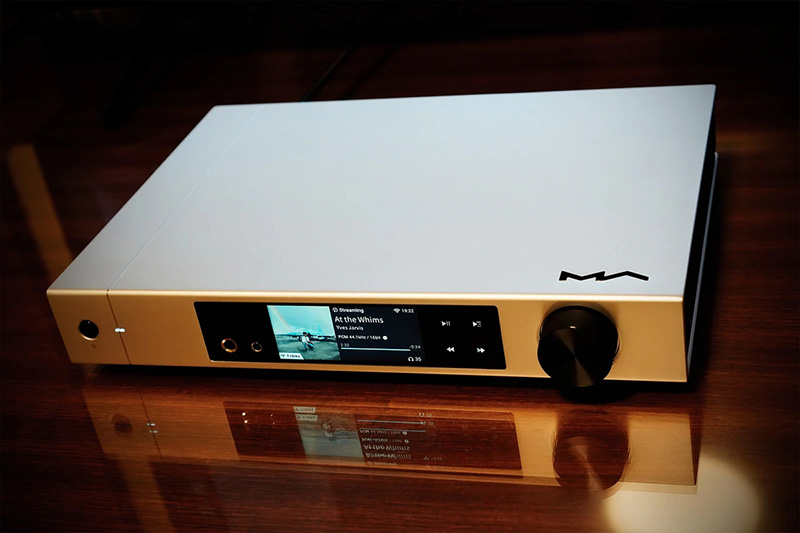
The all-new Matrix Audio element X2 Music Streamer is the future-ready answer for music lovers who have embraced the “streaming revolution”, and are looking for a versatile and streamlined all-in-one solution to act as the “brains” in their home audio or headphone-listening system. But the element X2 is so much more than simply a “music streamer” - with a generous smattering of digital, analogue and wireless connectivity options, a terrific interface plus a superb headphone amplifier baked inside, at $6,499.00 it could well be the most multi-talented device you could place at the heart of a desktop or two-channel audio setup.
Swim with the stream
As much as I love pulling out an LP or CD from my patiently-built music collection at home for that tactile experience of dropping the needle or pressing “play” (ok, that’s maybe not that tactile) with my favourite albums, I don’t need to tell you how incredible it is to have the ability to have practically every album ever recorded right there on-tap, online in glorious hi-resolution form with the simple tap of a thumb with my smartphone. I’ve dabbled with Tidal in the past as my go-to streaming service of choice and have recently moved over to Qobuz thanks to its substantial 192kHz hi-res music library. And while I usually like to stick to a physical music format when playing my favourite albums, Qobuz has me covered for everything else - discovering new music, dipping back into “guilty pleasures” from my high school years, and enjoying curated playlists to mix things up while I’m tapping away at work during the day.
With other providers like Apple Music now bringing lossless to the masses (c’mon Spotify, we’re getting sick of waiting…), streaming is not only abundant but it’s also become embraced as the mainstay musical source option of choice for many a hifi enthusiast - no longer do we need to fuss over turntable cartridges or SACD spinners to enjoy to have an audio setup deemed worthy of “audiophile” status. This being the case, a network audio streamer has become an essential way to help ensure both a seamless connection as well as an easy to live with interface when it comes to piping lossless or hi-res musical stream without any degradation in quality from the clouds, through to your ears.
Meet the element X2
Matrix Audio has become a well-renowned manufacturer in recent years thanks to their innovative audio products which blend digital and wireless connectivity in well-designed and packaged devices. Their brand new element X2, the flagship of their “element” series, has taken things up a notch as an evolution of Matrix’s technology and experience creating future-focused stand-alone source devices.
Calling the element X2 a “Music Streamer” really is selling the talents and applications of this device rather short. With Sabre’s flagship ESS9083PRO DAC chip tucked away under the hood mated with a Crystek CCHD-950 ultra-low phase noise femtosecond clock, a fully-balanced headphone amplifier able to pump out 2.6 Watts of power, seven wired digital inputs including HDMI ARC, plus single-ended and balanced analogue outputs, the element X2 could happily find its way into your audio system under any number of guises. For example:
A standalone headphone DAC/amplifier able to accept digital, analogue or wireless sources
A digital or analogue preamplifier to pair with a power amplifier or powered monitors
A streaming-capable DAC to pair with a traditional integrated amplifier or headphone amplifier
element X2 design and form-factor
The element X2 is one sleek-looking, solidly-built all-in-one device. Measuring 340mm (w) x 259mm (d) and 58mm (H), it’s actually pretty sleek considering it weighs-in at a reassuringly hefty four kilograms. The element 2’s main chassis is built a nicely finished single piece of matte grey aluminium, and being a relatively thin device I can see many owners slipping one under a desktop monitor, or stacking on top of an amplifier. Having a pretty minimalistic aesthetic, the element X2 will be able to easily find a way into your living room or workstation without calling out too much attention to itself. The sides of the device feature black metal “fins”, which presumably help with heat dissipation - the element X2 gets a little warm during operation, but not overly so (your cat will probably want to sit on it, however).
The only physical control on the element X2 is the large black volume knob on the front of the device which spins freely with subtle “clicks” to control the 100 levels of digitally-controlled volume, meaning there is no channel imbalance, even at low listening levels. “Click” the knob, and the element X2 can be muted if you need to in a hurry. Over on the left-hand side of the front of the element X2 are two headphone jacks - a standard 6.3mm single-ended connection plus a 4.4mm balanced one. Previous element models have featured full size XLR connections, but the adoption of Pentaconn for the new element line-up is a sign that this format is becoming more accepted, plus the smaller jack also helps to keep things more streamlined.
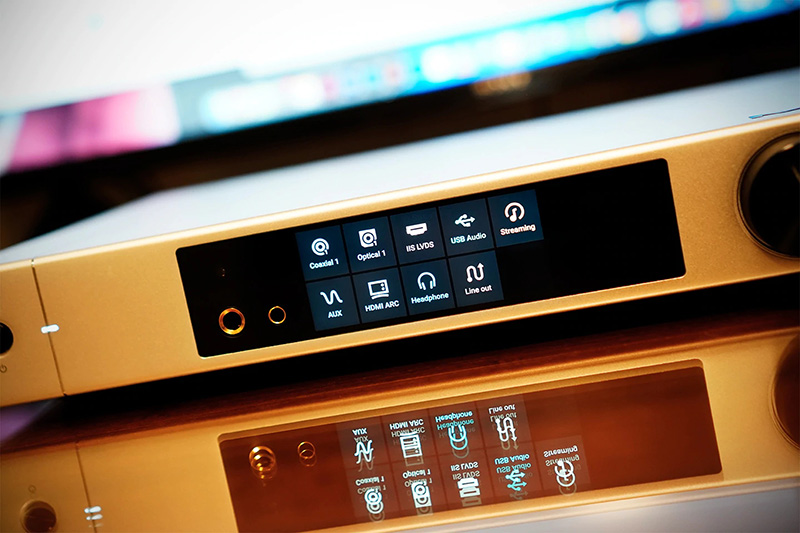
The “face” of the element X2 is dominated by a brightly-coloured 3.46-inch LCD touch-screen, which can be used to control the devices main settings, playback, input/output selection and more. It’s a great-looking screen and also makes for a pretty easy and intuitive way to interact with the element X2 - simply “swipe left” to access input/output, filter and settings, and “swipe right” to select from the seven available input options as well as switching between headphone and line-out modes. While it’s a great way to interact with the device if you feel like getting “hands on”, it also looks pretty great when it comes to displaying the cover art of the album that you're streaming - it adds a degree of tangibility to your listening experience. Or, if you feel like keeping things low key in a dark room, the screen can be dimmed completely.
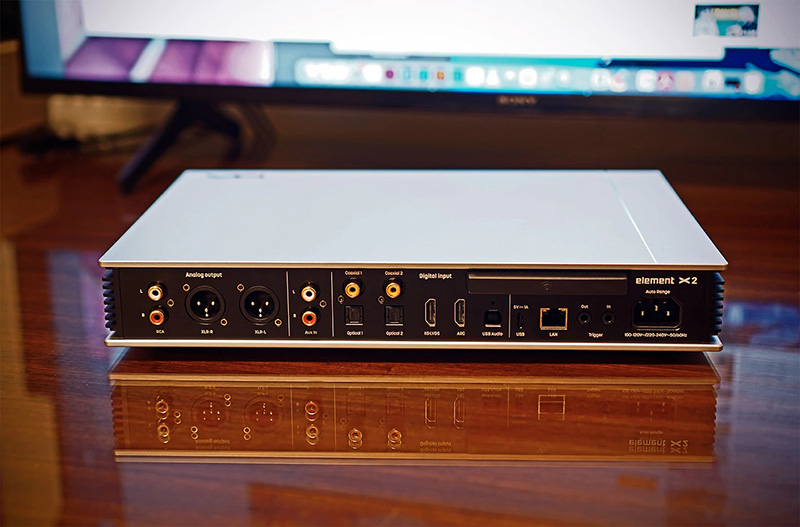
Despite being marketed as a “music streamer”, the back of the element X2 is chock-a-block full of inputs and outputs - it is one seriously versatile wired device as well, and will happily perform equally well as analogue as well as digital signals. On the left hand side there are both single-ended and balanced XLR outputs for using the element X2 as either a fixed-level DAC or to use it as a preamplifier with a variable output. One thing to note (which I learned the hard way) is that the line-out signal is set to “fixed” unless you change a setting in the companion Matrix Audio app, even if you turn down the volume dial in line-out mode - you’ll certainly get a shock when your power amp starting playing at full blast! An analogue input is also included if you want to keep things all-analogue with a turntable, or to feed the element X2 with a signal from another DAC and use its excellent preamplifier or headphone amplifier capabilities.
The element X2 offers no few than seven wired digital connection options to access the ES9038PRO DAC chip, including two optical and two coaxial inputs which can play up to 24-bit/192kHz PCM and DoP DSD 2.8mHz, the rarer “IIS LVDS” input which is shaped like an HDMI input (but has a different pin configuration) capable of playing up to 24-bit/768kHz PCM and Native DSD 22.4mHz, and a USB input which matches the specs of the IIS LVDS but adds full MQA compatibility up to 384kHz. The other input which sets the element X2 apart from similar devices is HDMI ARC - this inclusion adds a huge benefit in terms of adding the element X2 into a system with a TV or monitor. If your screen device supports Consumer Electronic Control you can control volume and other playback functions using your TV remote when connected to the element X2 via HDMI ARC.
A large plastic “bulge” on the rear of the element X2 houses the antenna for the onboard wifi card which is able to operate on both 2.GHz and 5GHz bands. A gigabit-speed ethernet connection is provided for connecting the element X2 to a local area network, and a USB-c socket allows you to an attached storage device. True to Matrix Audio’s intent of seeing the element X2 being able to be used as the “brains” of a larger audio system, 3.5mm mono trigger input and output sockets allow you have multiple devices switch on at once when you feel like listening in a hurry. Lastly, and IEC socket is provided for connecting the provided cable from your wall supply to the elements X2’s power input. Two separate power supplies are used inside for the ARM processor and the digital audio processing circuits, and the audio circuit used a completely independent linear power supply to ensure an uncorrupted music signal is sent out via the headphone or analogue outputs.
element X2 streaming and user experience
Matrix Audio has supplied their “RM4” remote control with the element X2. It’s a pretty comprehensive remote and allows you to easily switch between input options, change volume, select between digital filter settings (the ES9038PRO DAC has seven filter options, which all sound nigh-identical to this reviewer’s ears, as is the case with most DAC filter options), and control music playback.
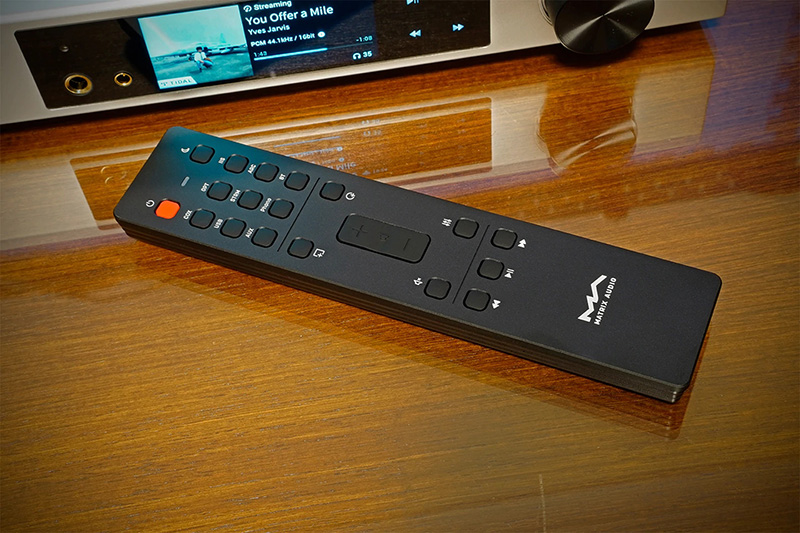
Getting deeper into the element X2’s settings and streaming options requires a download of the “MA Remote app” on either Android or Apple ecosystems. When your smartphone or tablet is on the same network as the element X2, the app gives you streaming options with both Tidal and Qobuz built-in, as well as a wide range of Internet Radio stations from around the world.
The native playback function with the MA app is “ok”. Tidal worked no problem at all, but I couldn’t manage to get Qobuz or Internet Radio stations working just yet - a future firmware download (managed via the app) may help correct this. Tidal users will probably feel more comfortable using the actual Tidal app which allows you to control streaming playback with the element X2 via “Tidal Connect”. Playback using Spotify Connect through the app on my Pixel 6 also worked perfectly, however the Qobuz app didn’t offer the element X2 as an audio output on my home wifi network.
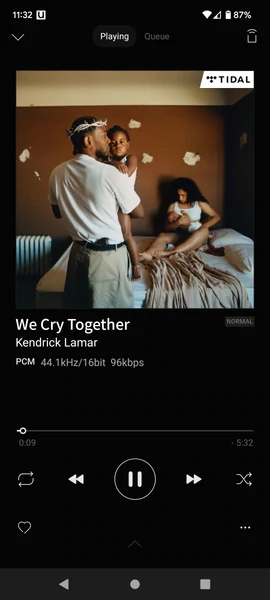
While I don’t have a network attached storage (NAS) system setup at home, the MA app can also allow you to browse through your music library housed on an appropriate storage device on your network or attached via the USB-c connection. The element 2’s Airplay 2 connectivity worked well when connected with it set as the audio output for my Macbook, and Roon was also able to identify it as an output device for managing wireless playback. Regardless of file type or bit-rate, I had a drop-out free listening experience at all times using the element X2’s wifi connection and so never once felt the urge to connect it to my home network via Ethernet. To round out the possible streaming applications for the element X2, if you do have a large digital music library at home the element X2 also has you covered if you wish to set up a DLNA/UPnP playback system.
I use Roon as my main music playback and streaming platform at home, and while the program recognised the element X2 as a “Roon Ready” device, Roon informed me that the Matrix Audio hasn’t yet completed Roon Certification for the element X2. I’ll be watching this area with great interest in the hope of an upcoming firmware update or Roon Certification, as having the element X2 function as a Roon “Endpoint” will no doubt mean that Tidal or Qobuz streaming will become far easier, and will also give access to all the digital tweaking options that Roon provides.
Unsurprisingly, the element 2 works flawlessly when used as a “wired” DAC. With the element X2 stationed in the middle of my home office desk, I had it simultaneously connected to my Macbook Roon core via USB, my CD transport via optical, and my Sony Bravia TV through HDMI ARC. Switching between inputs and outputs with the provided remote or MA app is a piece of cake, and if neither are handy the element X2’s touchscreen is both intuitive and easy to use. The on-screen play/pause and track advance/rewind “buttons” are super handy for managing playback if you have your music player minimised, and it’s possible to actually have a great user experience with the element X2 without ever picking up the remote or opening the app at all, however it would be nice to have the headphone gain levels and line-out/pre-out adjustability available as on-screen options or able as selectable options in the two programmable “spare” buttons on the remote.
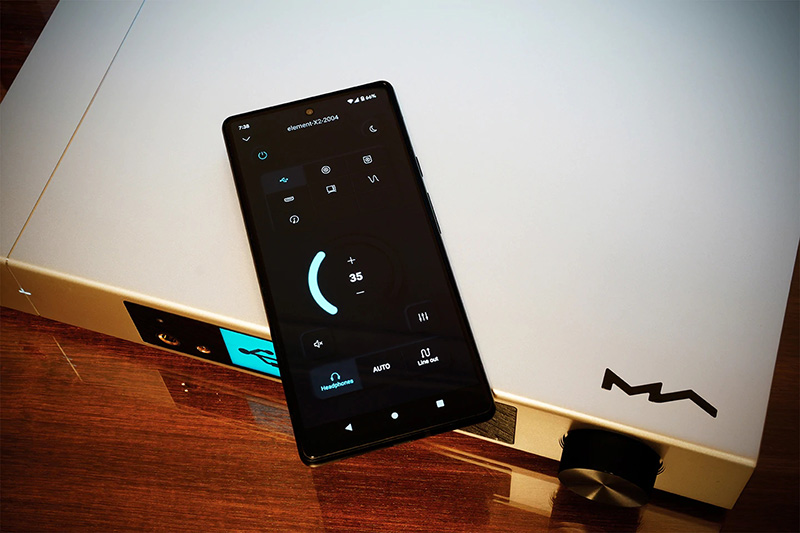
The MA app also provides all the same handy features as the physical remote if you feel like keeping device controls all on the one screen, and also gives you greater control over a number of other device settings such as changing the line-out/pre-out function, switching between high/low gain in headphone output mode, changing the gain of the analogue inputs, setting volume limits, screen brightness settings, and more. If you want to get even more technical, a bunch more digital “tweaking” options are provided including the ability to switch between asynchronous/synchronous digital conversion modes, managing jitter elimination, dither, and more.
Listening to the element X2
After overcoming my initial confusion as to how to set the analogue outputs into variable mode after delving through the app (you can actually select 0dB gain or +10dB variable gain options), I initially spent about a week using the element X2 purely as a preamplifier in my nearfield setup on my desktop with the variable output set to +10dB and connected to my Burson Audio Funk Headphone & Speaker Amplifier powering a pair of Dynaudio Evoke 20 Bookshelf Speakers which I have set up on stands about a foot out from my treated office rear wall and angled in towards my listening position. Being pretty intimate with the signature of the Class A/B Funk, I quickly got the impression that the element X2 was sending out a rather uncoloured digitally-converted signal, and has an incredibly detailed yet still natural-sounding DAC stage. The reason I didn’t get around to headphone listening for a good week or so was because the element X2 just sounded so damn good as a digital preamplifier. I was seriously digging the nice, wide stereo separation and rock-solid centre image for the vocal parts in a 24-bit/96kHz Qobuz stream of Spoon’s Hot Thoughts which felt far more immersive and big than it ought to in a nearfield setup like this.
While I had the element X2 performing preamplifier duties, I took the opportunity to see how the analogue input performed with my Rega Planar 2 turntable hooked up. I dropped the needle on Radiohead’s In Rainbows LP, boosted the analogue input gain by +6dB with the MA app (incoming gain can also be set to -6dB and 0dB depending on your source), and pressed the “AUX” button on the element X2’s remote. I was interested to see on the display screen that the element X2 was converting “Analog to PCM”, as I presumed that there might have been a straight-forward analogue pass-through to the preamplifier section yet it seems that incoming analogue signals are converted into the digital domain. Were it not for the on-screen display, I honestly wouldn’t have known that this record (which I must have spun hundreds of times) wasn’t a completely analogue signal - every little echoey vocal reverb and guitar pluck in the track Nude (Radiohead’s “prettiest song”) sounded entirely organic, and just like the vinyl pressing that I know and love.
The element 2’s fully-balanced headphone amplifier has impressive specifications on paper, being capable of 2.6 Watts into 33-ohms (which drops down to a still-impressive 1.6 Watts out of the single-ended output). The specs that were even more interesting to me as a headphone reviewer were the substantial power available to higher-impedance headphones - 1.1 Watts into 300-ohms and 580mW into 600-ohm headphones from the balanced output. The output impedance of the headphone amplifier is slightly on the higher side at<12-ohms and <6-ohms from the balanced and single-ended outputs respectively, and I did get a sense of a very mild yet still extremely tasteful lift in mid-bass from the 14-ohm Audeze LCD-5 Reference Planar Magnetic Open Back Headphones compared to headphone amplifiers with <1-output impedance. While there is more than enough power here on tap for low-impedance planars (and it also sounds very, very good) I’d suggest giving the element X2 a try in-store to get a sense of how it sounds to you. Using the old “rule of eighths” when it comes to impedance matching - that is, the impedance of a headphone should be roughly 8 times higher than the output impedance of an amplifier - this tells me that the element X2 will shine when it comes to dynamic driver headphones over with over 100-ohms impedance.
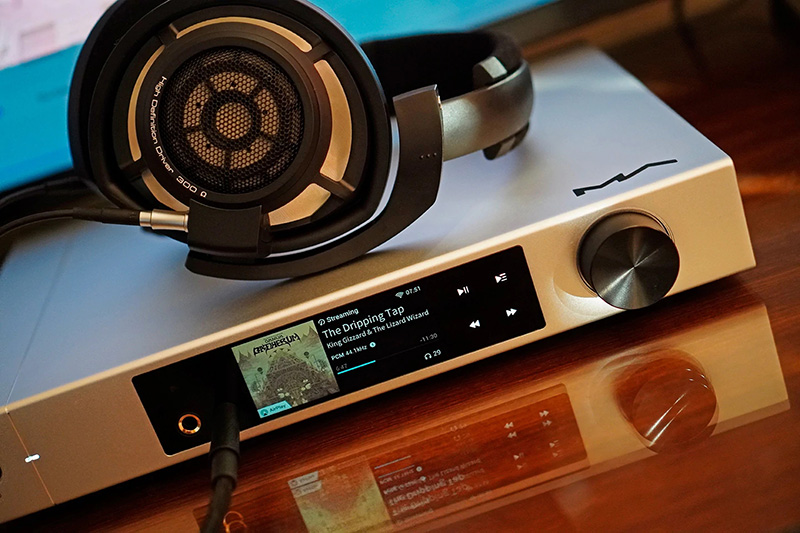
To put this theory to the test, I brought out my favourite high-impedance dynamic driver headphones, the 300-ohm Sennheiser HD800s Audiophile Headphones and hooked them up to the element X2 using the HD800s’ 4.4mm cable (which I don’t really get the opportunity to use all that often!). Switching the element X2 into high gain using the MA app and slowly turned-up the volume on a Qobuz version of King Gizzard and the Lizard Wizard’s newest album Omnium Gatherum streamed via Airplay. 24/100 was the absolute loudest I could go with the HD800s before things got “too loud” - the element X2 is an absolute beast when it comes to high-impedance headphones. And how does it sound? Bloody awesome. The X2 provides a deep level of clarity and insight into the inner workings of a track when using a revealing pair of cans like the HD800s, and while it’s not a laid-back sound by any stretch of the imagination, there’s a nice splash of added warmth that keeps things from ever getting too sterile or fatiguing. I like the default tuning of the HD800s and I don’t tend to temper its strident treble with EQ like many owners, but it can get pretty spicy after a while with some amps - this definitely not the case with the element X2.
The soundstage and image presentation with the HD800s felt brilliantly recreated when pairing it with the element X2, but it was the closer details that impressed me most - Chris Cornell’s vocals in the live recording of Cleaning My Gun sounded breathtakingly intimate, and there was so much evident texture and nuance that it sounded, well, “analogue” for lack of a better term.
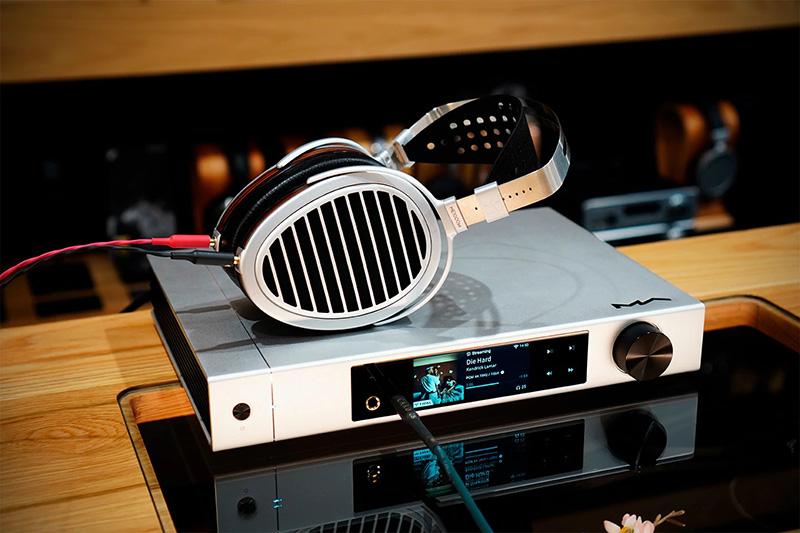
Curious to see how the element X2 would fare with a lower-impedance planar I spent some time listening to Kendrick Lamar’s latest album Mr. Morale & The Big Steppers with the excellent HIFIMAN HE-1000se Planar Magnetic Headphones. The HE-1000se’s brilliant tuning and tonality shone through with the element X2 which displayed a vice-like grip and authoritative shove with the thumping bass in the track Die Hard, and there was a pleasant feeling of cosy warmth which perfectly matched the HE-1000se’s velvety tone. The element X2 certainly won’t gloss over the imperfections in a recording - some (deliberate?) crackling and distortion was definitely audible with such a revealing pairing. The element X2 also reveals the excellent spatial qualities of the HE-1000se - I did have one interesting moment at the start of track #5, Father Time, where the distant “tapping” noises actually made me think that someone was knocking at the door!
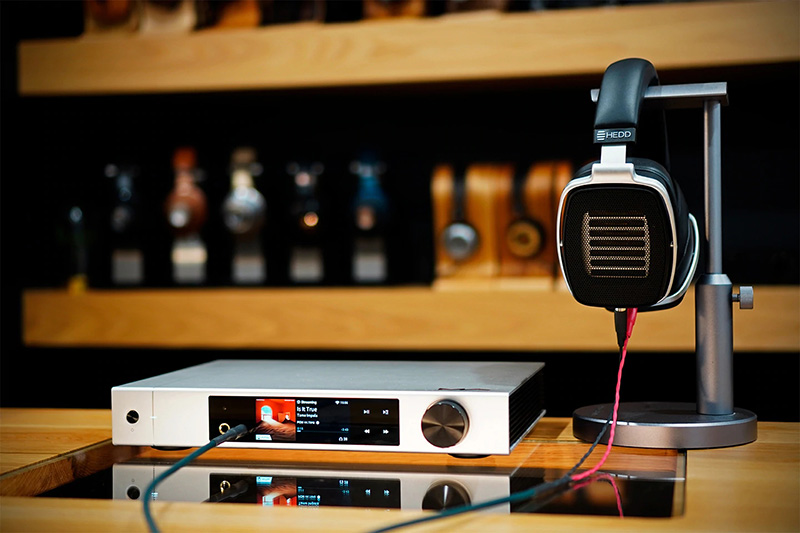
The HEDD HEDDphone AMT Headphones are not only curiously distinctive headphones thanks to their Air Motion Transformer drivers (plus their looks!), but they’re also a particularly difficult load for an amplifier with a low sensitivity of 87dB and I’ve found that I need to seriously crank an amp to get them up to normal listening levels - not so with the element X2, which had the HEDDphone sounding utterly convincing at just 28/100 in high gain. The element X2 brought out an incredibly fast and responsive bass performance from the HEDDphone in Tame Impala’s Lost in Yesterday, and in terms of sheer airy detail and lightning-fast transient response this pairing was as impressive as anything I’ve heard - it was positively scalpel-like.
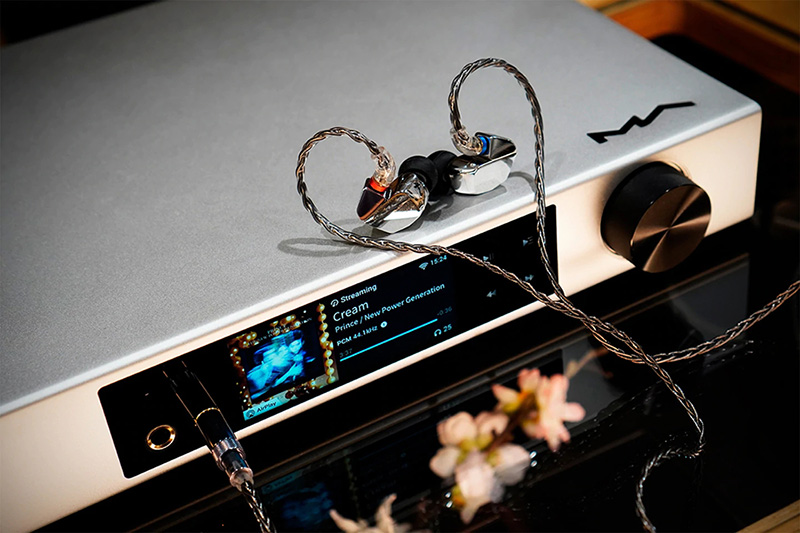
To round out my headphone testing with the element X2 I plugged in the Final Audio A8000 Flagship In Ear Monitors to see whether it’s a viable proposition for IEM listeners. In short, yes it is - in low gain there was a barely audible background noise floor, but a PC fan or music playing at anything louder than “00” will make it disappear immediately. An enjoyable listen to Prince’s Cream made me remember why the A8000 is my favourite single dynamic driver IEM - their crystalline treble sounded absolutely perfect through the element X2 (which was playing at 25/100 in low gain) with astonishing levels of incisive detail and separation that made for a crazy holograph-like effect with the “Purple One’s” double-tracked vocals, supported by a tasty foundation of low-end dynamic slam that sounded far too good to be coming out of those tiny dynamic drivers.
Final thoughts
Putting aside for a moment the fact that the Matrix Audio element X2 is at its heart a music streamer, it’s a downright impressive product if you had no idea that it has wifi streaming capabilities. With it’s terrific DAC and impressive amount of inputs and outputs, it’s already a first rate DAC, preamplifier, and a particularly excellent headphone amplifier. However, whether you’re on the fence about moving to a streaming setup or you’re already streaming so to your heart’s content, the element X2 will have you covered on that front (and then some) with a well-implemented user interface, app and strong network performance on top of an already impressive list of versatile talents.
With its impending Roon certification around the corner, I expect the element X2’s already great wireless credentials to become even better, and as a Roon Ready DAC/streamer/preamp/headphone amplifier it will be an extremely difficult product to walk past if you’re invested in the Roon ecosystem (and if you’re not, you’re definitely missing out). I’ll also continue to look at how to get Qobuz operating natively with the element X2 and will update once I get to the bottom of things (admittedly, it could be me).
I can heartily recommend the element X2 as both a digitally-focused streaming preamplifier and as an “ultimate” all-in-one headphone amplifier solution, squeezing your musical source, DAC, and amplifier into one very attractive, very nice-sounding package indeed. Thanks to its HDMI ARC inclusion, I'd be very happy to have one parked right in the middle of my living room to act as the quarterback of my home audio system!